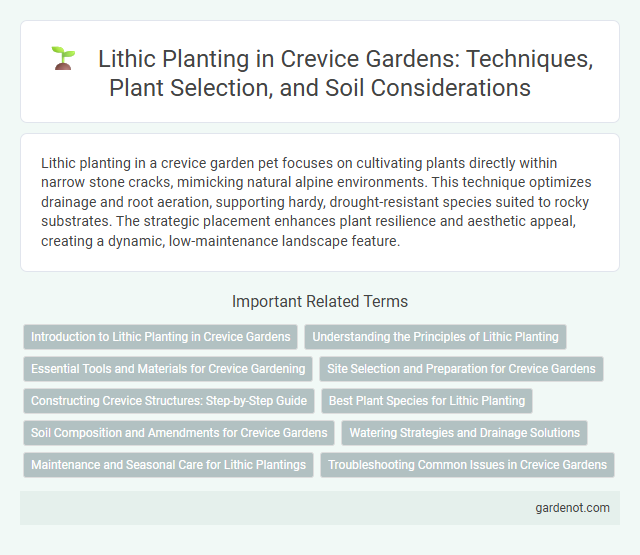Lithic planting in a crevice garden pet focuses on cultivating plants directly within narrow stone cracks, mimicking natural alpine environments. This technique optimizes drainage and root aeration, supporting hardy, drought-resistant species suited to rocky substrates. The strategic placement enhances plant resilience and aesthetic appeal, creating a dynamic, low-maintenance landscape feature.
Introduction to Lithic Planting in Crevice Gardens
Lithic planting in crevice gardens involves cultivating plants in narrow, rocky fissures that mimic natural alpine environments. This method optimizes drainage and reduces soil depth, supporting drought-tolerant species such as saxifrages, sedums, and alpine asters. Crevice gardens enhance microclimates and root aeration, promoting healthy growth in challenging conditions.
Understanding the Principles of Lithic Planting
Lithic planting involves arranging vegetation within rocky crevices to optimize moisture retention and root anchorage in challenging terrains. This technique mimics natural alpine and cliff habitats, promoting biodiversity by selecting drought-tolerant and shade-adapted species. Proper lithic planting enhances soil stability and supports microhabitats crucial for resilient ecological restoration in crevice gardens.
Essential Tools and Materials for Crevice Gardening
Essential tools for lithic planting in crevice gardening include hand trowels, narrow weeding forks, and precision pruners, which facilitate careful soil placement and plant maintenance within tight rock crevices. Key materials involve well-draining, gritty substrates such as a mix of coarse sand, decomposed granite, and organic compost to mimic natural alpine or rocky habitats. Incorporating moisture-retentive layers like sphagnum moss and utilizing mineral-rich stones such as limestone or granite enhance root anchorage and nutrient availability for successful crevice garden cultivation.
Site Selection and Preparation for Crevice Gardens
Site selection for lithic planting in crevice gardens requires well-drained, sunny locations with minimal soil to mimic natural rocky habitats. Preparation involves arranging stones vertically or at angles to create narrow, deep fissures that retain moisture while promoting root aeration. Using sand or gritty substrate between rocks enhances drainage and supports drought-tolerant alpine or succulent species adapted to harsh, nutrient-poor conditions.
Constructing Crevice Structures: Step-by-Step Guide
Constructing crevice garden structures involves carefully stacking flat stones vertically to create deep, narrow gaps that mimic natural rock fissures ideal for lithophyte and alpine plant roots. Begin by selecting durable, weather-resistant rocks and arrange them securely in layers, ensuring stability and adequate drainage within the crevices. Incorporate a well-draining soil mix tailored for xerophytic plants to promote healthy root growth in the constructed vertical crevices.
Best Plant Species for Lithic Planting
Best plant species for lithic planting in a crevice garden include saxifrage, sedum, and thyme, which thrive in rocky, well-drained environments with minimal soil. These plants exhibit exceptional drought tolerance and root penetration ability, making them ideal for narrow stone crevices. Hardy alpine plants like dianthus and sempervivum also adapt well, enhancing biodiversity and aesthetic appeal in lithic landscapes.
Soil Composition and Amendments for Crevice Gardens
Lithic planting in crevice gardens demands a soil composition that mimics natural rock fissures, typically a well-draining mix of gritty sand, coarse grit, and minimal organic matter to prevent water retention. Amendments such as crushed granite, decomposed granite, or volcanic pumice enhance aeration and drainage, promoting root health in shallow substrates. Maintaining the right balance of mineral-rich soil with low fertility supports the growth of alpine and lithophyte plants adapted to nutrient-poor, rocky environments.
Watering Strategies and Drainage Solutions
Lithic planting in crevice gardens requires precise watering strategies to mimic natural rainfall while avoiding waterlogging, optimizing plant health by applying minimal, deep watering. Efficient drainage solutions include incorporating layered substrates with coarse gravel and sand to facilitate rapid water runoff and prevent root rot. Proper design ensures excess water quickly escapes, maintaining essential aeration within lithic crevices for drought-tolerant species.
Maintenance and Seasonal Care for Lithic Plantings
Lithic planting in crevice gardens requires careful maintenance to ensure plant health and longevity, focusing on well-drained substrates and minimal soil retention. Seasonal care involves monitoring moisture levels during dry periods and protecting roots from frost in winter by adding mulch or insulating materials between crevices. Regular removal of debris and occasional pruning encourage robust growth and prevent disease in lithophyte species adapted to rocky environments.
Troubleshooting Common Issues in Crevice Gardens
Lithic planting in crevice gardens often faces challenges such as poor drainage, which can lead to root rot in drought-tolerant species like sedums and sempervivums. Addressing soil compaction and ensuring adequate mineral-rich substrate can prevent nutrient deficiencies common in rocky crevice environments. Regular monitoring for pests such as aphids and fungal diseases helps maintain plant health in these specialized lithic systems.
Lithic planting Infographic

 gardenot.com
gardenot.com